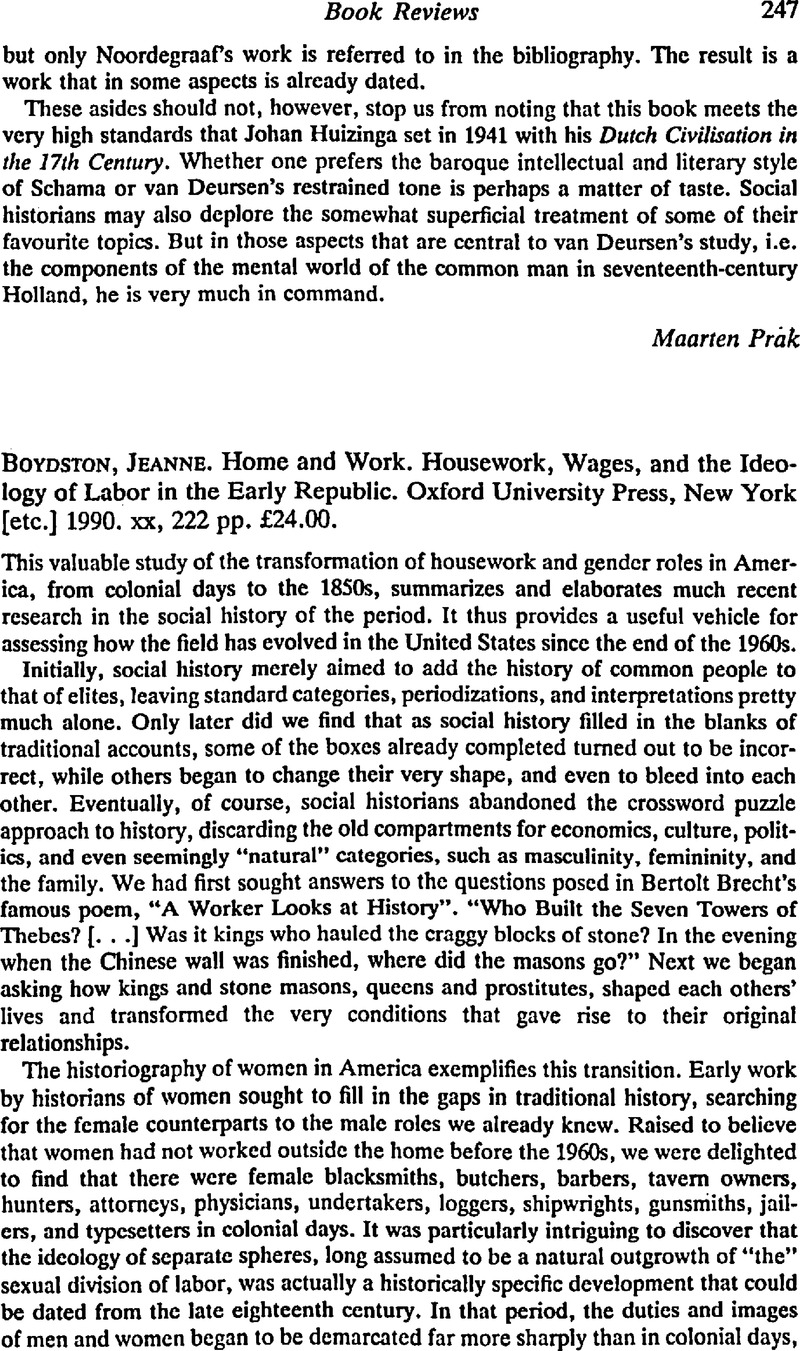Article contents
Jeanne Boydston. Home and Work. Housework, Wages, and the Ideology of Labor in the Early Republic. Oxford University Press, New York [etc.] 1990. xx, 222 pp. £24.00.
Published online by Cambridge University Press: 20 February 2009
Abstract

- Type
- Book Reviews
- Information
- Copyright
- Copyright © Internationaal Instituut voor Sociale Geschiedenis 1993
References
2. The attack on the “Golden Age” hypothesis is summarized in Norton, Mary Beth, Liberty's Daughters: The Revolutionary Experience of American Women, 1750–1800 (Boston, 1980)Google Scholar and Kochlcr, Lyle, A Search for Power: The “Weaker Sex” in Seventeenth Century New England (Chicago, 1980)Google Scholar.
3. Ulrich, Laurel Thatcher, Good Wives: Image and Reality in the Lives of Women in Northern New England, 1650–1750 (New York: Alfred Knopf, 1982).Google Scholar
4. Henretta, James, “Families and Farms: Mentalite in Prc-industrial America“{William and Mary Quarterly 35 1978), 3–32;CrossRefGoogle ScholarDawley, Alan, Class and Community: Tlte Industrial Revolution in Lynn (Cambridge, MA: Harvard University Press, 1976)Google Scholar; Johnson, Paul E., A Shop-keepers' Millennium: Society and Revivals in Rochester, New York, 1815–1837 (New York: Hill and Wang, 1978)Google Scholar; Wilcntz, Scan, Chants Democratic: New York City and the Rise of the American Working Class, 1788–1850 (New York: Oxford University Press, 1984)Google Scholar.
5. Ryan, Mary, Cradle of the Middle Class: The Family in Oneida County, New York, 1790–1856 (New York: Cambridge University Press, 1981);Google ScholarGendered Domains: Rethinking Public and Private in Women's History, edited by Helly, Dorothy V. and Reverby, Susan M. (Ithaca: Cornell University Press, 1992)Google Scholar; Kerber, Linda, “Separate Spheres, Female Worlds, Woman's Place: The Rhetoric of Women's History”, Journal of American History 75 (1988), 9–39.CrossRefGoogle Scholar See also Ostcrud, Nancy Grey, Bonds of Community: The Lives of Farm Women in Nineteenth-Century New York (Ithaca: Cornell University Press, 1991)Google Scholar.
6. A good start for making such distinctions between the interests of women as wives and as single workers can be found in Stansell, Christine, City of Women: Sex and Class in New York, 1789–1860 (New York: Knopf, 1986)Google Scholar and Blewett, Mary, Men, Women, and Work: Class, Gender, and Protest in the New England Shoe Industry, 1780–1910 (Urbana: University of Illinois Press, 1988)Google Scholar.
7. Roediger, David, Tiie Wages of Whiteness: Race and the Making of the American Working Class (London: Verso, 1991);Google ScholarLincbaugh, Peter, Vie London Hanged: Crime and Civil Society in the Eighteenth Century (Cambridge, England: Cambridge University Press, 1992)Google Scholar.
- 1
- Cited by




